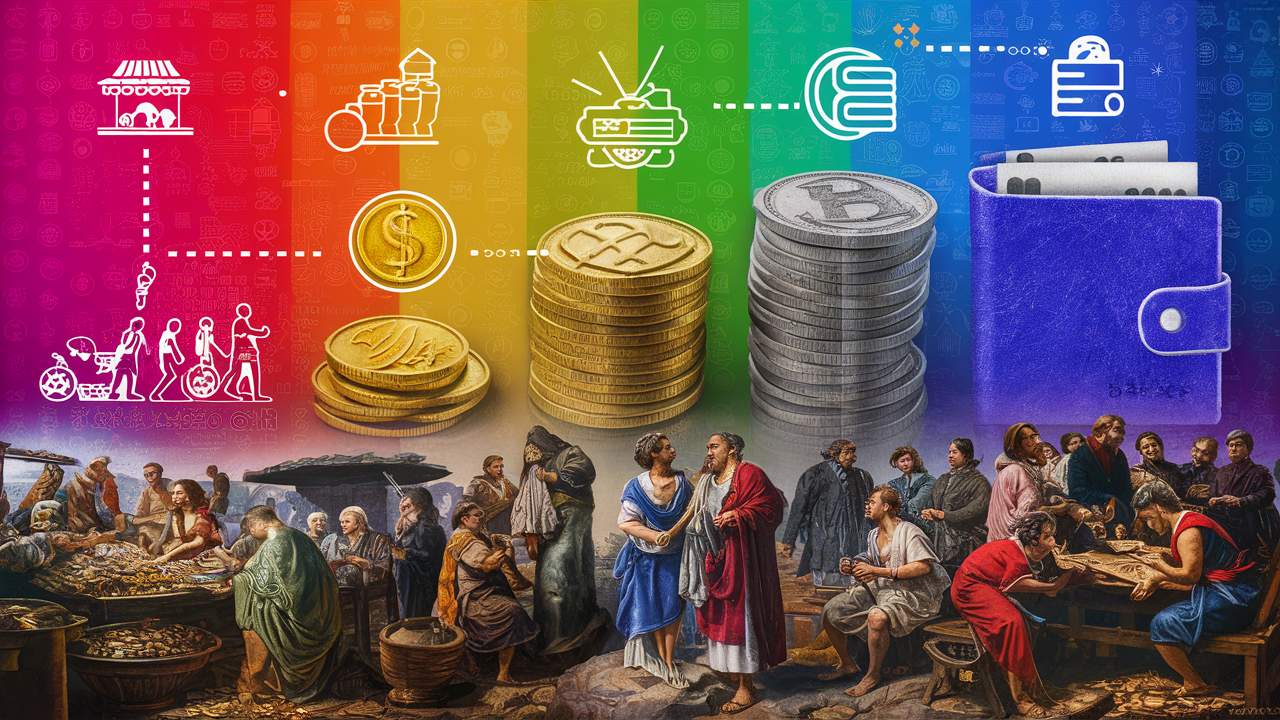Introduction
Barter systems have been integral to human economic interactions long before the development of the history of money. In ancient societies, transactions were conducted without money supply or paper currency, relying solely on the exchange of goods and services. These early trade practices laid the foundation for the evolution of money, progressing from simple barter to more sophisticated systems involving gold coin and silver and gold as recognized forms of money.
As civilizations like Mesopotamia, Egypt, and China grew, the limitations of barter systems became evident. The absence of credit cards and debit cards made transactions cumbersome, necessitating the creation of a form of money that could standardize value exchange. This need spurred the invention of money, with institutions such as the national bank beginning to issue the first bank note. Over time, the transition from barter to paper currency marked a pivotal shift in economic systems, highlighting the dynamic nature of financial exchanges from ancient times to the present.
Key Takeaways
- Barter systems were fundamental before the development of the history of money, relying on direct exchanges of goods and services in ancient societies.
- The transition from barter to commodity money like gold coin and silver and gold marks a significant evolution in economic systems, offering a more standardized form of money.
- Limitations of barter, such as the need for a double coincidence of wants, drove the invention of money and the use of paper currency.
- Credit cards and debit cards are modern representations of the evolution from physical form of money to digital transactions, reflecting the continuous development of financial systems.
- The establishment of the national bank and the issuance of the first bank note were pivotal in transitioning to organized financial systems.
- From ancient times to the present, the dynamic changes in money forms and systems highlight the adaptability and complexity of human economic interactions.
The Emergence of Commodity Money
Commodity money, inherently valuable due to its own worth, differs significantly from representative forms like paper money. Historically utilized in various forms, including salt, shells, and notably precious metals such as gold and silver, commodity money simplified and standardized transactions across civilizations. This transformation allowed for a universally accepted medium of exchange, which facilitated more effective trade and economic development.
History of bartering
Bartering, the earliest form of economic exchange, involved direct trade of goods and services without a standardized medium. This system, although foundational, required the exact alignment of needs between parties, often complicating transactions. The introduction of items with intrinsic value like cattle, which later included precious metals, helped to address these complexities.
From Bartering to Currency
The transition from bartering to using commodity money laid the groundwork for modern monetary systems. As communities recognized the limitations of bartering, the need for a more reliable, divisible, and transportable form of money led to the creation of currency systems. This evolution was marked by significant milestones, such as the minting of copper coins in the late 7th century BC, which circulated widely, transforming trade dynamics.
The Rise of Metal Coinage
Metal coinage, originating around 600 BCE in ancient Lydia, now part of Turkey, represented a significant advancement in monetary systems. The Lydians pioneered the use of electrum coins, a blend of gold and silver, which were embossed with symbols to signify their authenticity and value. This innovation not only made transactions more straightforward and more portable but also laid the groundwork for more complex financial systems.
Key Milestones in the Evolution of Currency Systems
-
Introduction of Electrum Coins (circa 600 BCE): In ancient Lydia, the creation of coins made from electrum, a natural alloy of gold and silver, marked the beginning of standardized currency. These coins facilitated easier and more reliable transactions compared to bartering.
-
Widespread Use of Metal Coins (7th Century BC to Middle Ages): As metal coins spread from Lydia to other civilizations, they became essential in expanding trade networks and were instrumental in developing economic structures across empires.
-
Transition to Paper Money (12th Century): Initially used in China, paper money represented a significant shift from metal coins, driven by the need to manage larger transactions more efficiently and safely.
-
Legal Tender Status (Various Dates): Over the centuries, different forms of money were declared as legal tender in various regions, further formalizing the role of currency in society and stabilizing economic systems.
-
Digital Currency Evolution (Late 20th Century to Present): The introduction of digital transactions and cryptocurrencies like Bitcoin represents the latest phase in the evolution of money, offering global, instantaneous financial interactions without the physical limitations of traditional currency.
This list outlines the major developments in the history of currency, highlighting how innovations from electrum coins to digital currencies have shaped economic interactions and systems over millennia.
When Were Coins Replaced by Paper Money?
The shift from metal coins to paper money began significantly in the 12th century, a development driven by the need for a more convenient method of handling large transactions. Paper money became the preferred medium in various regions, facilitated by the establishment of state-backed issuing authorities. This transition was marked by the evolution of financial practices, moving from the tangible value of metal to the representative value of paper.
First metal money — coins
Metal coins were the first true form of currency, offering a standardized and universally accepted medium that enhanced trade efficiency. These coins bore face value, which was essential for establishing a common measure across different trade systems. Their introduction allowed for the accumulation and easier transfer of wealth, which was crucial in expanding trade networks and developing economic structures.
The Development of Paper Money
The inception of paper money in ancient China marked a revolutionary shift in economic transactions, as merchants and traders began using deposit receipts as a currency alternative. These early forms of paper money greatly surpassed the conveniences of metal coinage, offering enhanced portability and simpler storage options. As these receipts transitioned into recognized mediums of exchange, they supported the facilitation of larger transactions, paving the way for more expansive business operations.
When Were Coins Replaced by Paper Money?
Coins began to be replaced by paper money significantly in the 16th century, particularly as economies expanded and the limitations of coinage—like weight and difficulty in large quantity transport—became apparent. The first paper currency issued by a government provided a more practical means of conducting extensive commerce and managing state economies. This shift was crucial in the development of modern financial systems, where paper currency remains a foundational element.
Transition to Paper Currency
The transition to paper currency was driven by the need for a more efficient, secure, and scalable monetary system than what metal coins could offer. Paper money, initially recognized as a legal tender in various nations, facilitated economic growth by making transactions smoother and more flexible. This evolution also spurred the development of early banking systems, where paper money enabled the secure transfer of large sums and supported the burgeoning trade and commerce sectors.
The Role of Banking in Early Money Systems
Early banking systems were instrumental in shaping the financial landscape of burgeoning economies, providing secure methods for storing and transferring wealth as global trade volumes grew. These banks emerged as pivotal institutions by offering services like the issuance of currency and credit, which facilitated broader economic development and market expansion. Additionally, the ability to regulate the flow of money gave banks a significant influence on the monetary policies of their times.
The gold standard
The gold standard was a critical development in early banking, establishing amount of gold as a direct representation of currency value. This system ensured that paper money issued by banks was directly pegged to a specific amount of gold, stabilizing economies by preventing rampant inflation and fostering international trade reliability. Early banks adhered to this standard rigorously, reinforcing their role as stabilizing forces in the financial sectors of their respective regions.
The Emergence of Currency Wars
Currency wars often emerged when countries manipulated their currency values to gain a trade advantage, a situation exacerbated by the competitive issuance and regulation of money by early banks. These financial strategies involved devaluing one’s currency to boost export competitiveness, affecting global trade and economic balance. The role of early banking in these currency wars was significant, as banks facilitated rapid changes in money supply, influencing national economic strategies and international relations.
“Banks have thus become in a considerable degree the vehicles of intercourse between dealers, not only of different parts of the same community, but of different parts of the world; they are in this view the principal instruments of commercial reciprocity and of international exchange.” – Alexander Hamilton
The Impact of Early Money Systems on Trade and Commerce
Early money systems dramatically reshaped trade and commerce by enabling the large-scale exchange of goods and services across diverse regions. Standardized currencies facilitated seamless transactions and cultural exchanges, leading to the creation and expansion of vast trade networks. This financial infrastructure not only boosted local economies but also played a crucial role in global economic integration.
The impact of money throughout history
Throughout history, the evolution of money from barter systems to standardized currencies has been pivotal in developing economic structures and enhancing trade efficiency. The introduction of coins, and later, paper money, provided a reliable medium for value exchange, promoting the growth of merchant classes and the establishment of thriving commercial centers. These developments enabled a more dynamic marketplace where ideas, goods, and services could circulate with unprecedented ease, contributing to periods of significant cultural and economic growth.
Virtual Currency
The modern iteration of early monetary innovations is the emergence of virtual currencies, like bitcoin, which embody the principles of universal access and digital transaction. Virtual currencies leverage technology to offer a decentralized and global approach to finance, echoing the transformative impacts of the earliest forms of money. Just as the type of currency evolved over the centuries, from tangible assets to digital tokens, these digital currencies continue to influence global commerce, changing how we understand and interact with money.
The Legacy of Early Money Systems in Modern Economics
The legacy of early money systems is profoundly evident in modern economics, where standardized currencies continue to serve as the backbone of global trade and commerce. The principles established by ancient monetary practices are foundational to today’s economic policies and theories, helping stabilize and guide financial interactions worldwide. Furthermore, the evolution of banking from primitive lending systems to complex financial institutions underscores the enduring impact of these early innovations.
How Long Has Money Been Around, and What Were the First Forms of Value Exchange?
Money has been a cornerstone of human civilization for thousands of years, with the first forms of value exchange dating back to simple bartering systems. These early transactions involved direct exchanges of goods and services before the advent of coins which were initially minted in the 7th century BC. Over time, these primitive forms evolved into more sophisticated mediums like issued paper money, fundamentally changing the dynamics of how value was measured and exchanged.
What are the roots of currency?
The roots of currency can be traced back to ancient civilizations, where the need for a standardized medium of exchange led to the creation of the first coins. These early coins, often made of precious metals like gold and silver, provided a tangible way to store and exchange value, laying the groundwork for modern financial systems. The transition from barter to currency marked a significant evolution in economic practice, reflecting a shift towards more complex and interconnected trade systems.
[lasso rel=”amazon-34″ id=”10231″]
Conclusion
The influence of early money systems extends deep into the modern economic landscape, where the principles developed through millennia continue to shape fiscal policies and market behaviors today. These systems introduced standardized currency forms like coins and paper money, providing a reliable foundation for trade and commerce that enabled the American colonies and other regions to prosper. Additionally, the evolution from tangible coins to digital transactions underscores the enduring relevance of these foundational monetary mechanisms.
As we examine the history and evolution of currency, it’s clear that the enduring impact of early money systems is profound. From bartering in ancient markets to sophisticated banking systems that create money and manage national economies, these systems have facilitated the expansion of global trade networks. The ongoing transition to digital currency and platforms like Bitcoin reflects the continuous innovation within financial systems, ensuring that the legacy of ancient economic practices remains relevant in today’s modern economies.















